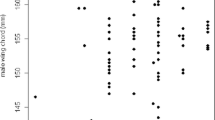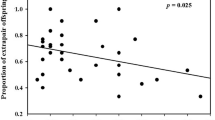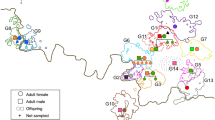Abstract
Extra-pair copulation without apparent direct benefits is an evolutionary puzzle that requires indirect fitness benefits to females to explain its ubiquity in socially monogamous mating systems. Using wild scarlet rosefinches (Carpodacus erythrinus), we tested if genetic benefits in the form of global (microsatellite) heterozygote advantage, adaptive genes (major histocompatibility complex), or complementary genes (using both markers) were responsible for female extra-pair mate choice, while considering that the benefits of mate choice may be conditional on female genotype. We found no evidence for assortative or relatedness-based mating (complementary genes), but higher MHC diversity, microsatellite heterozygosity, and condition were significantly related to male extra-pair paternity (EPP) success. In contrast, female probability of having extra-pair offspring decreased with increasing heterozygosity. Interestingly, extra-pair and within-pair males had higher heterozygosity than their female mates and extra-pair males had higher MHC supertype diversity. The only genetic difference between extra-pair and within-pair offspring was lower variance in MHC allelic diversity within extra-pair offspring, providing limited support for indirect genetic fitness benefits for the markers tested. Offspring had both higher neutral heterozygosity and number of MHC supertypes than adults, as well as significant identity disequilibrium, potentially suggesting that mates are chosen to increase offspring diversity in the period of the present study. Overall, our results point to an EPP heterozygote advantage for males, especially when involving less heterozygous females, and suggest that heterozygosity effects on reproduction may differ between the sexes.



Similar content being viewed by others
References
Aeschlimann P, Häberli M, Reusch T, Boehm T, Milinski M (2003) Female sticklebacks Gasterosteus aculeatus use self-reference to optimize MHC allele number during mate selection. Behav Ecol Sociobiol 54:119–126
Agudo R, Carrete M, Alcaide M, Rico C, Hiraldo F, Donázar JA (2012) Genetic diversity at neutral and adaptive loci determines individual fitness in a long-lived territorial bird. Proc R Soc Lond B 279:3241–3249
Akçay E, Roughgarden J (2007) Extra-pair paternity in birds: review of the genetic benefits. Evol Ecol Res 9:855
Albrecht T (2004) Edge effect in wetland-arable land boundary determines nesting success of scarlet rosefinches (Carpodacus erythrinus) in the Czech Republic. Auk 121:361–371
Albrecht T, Schnitzer J, Kreisinger J, Exnerová A, Bryja J, Munclinger P (2007) Extrapair paternity and the opportunity for sexual selection in long-distant migratory passerines. Behav Ecol 18:477–486
Albrecht T, Vinkler M, Schnitzer J, PolÁKovÁ R, Munclinger P, Bryja J (2009) Extra-pair fertilizations contribute to selection on secondary male ornamentation in a socially monogamous passerine. J Evol Biol 22:2020–2030
Amos W, Wilmer JW, Fullard K, Burg T, Croxall J, Bloch D, Coulson T (2001) The influence of parental relatedness on reproductive success. Proc R Soc Lond B 268:2021–2027
Arnqvist G, Kirkpatrick M (2005) The evolution of infidelity in socially monogamous passerines: the strength of direct and indirect selection on extrapair copulation behavior in females. Am Nat 165:S26–S37
Bates D, Maechler M, Bolker B, Walker S (2014) lme4: Linear mixed-effects models using Eigen and S4. R package version 1.1–7, http://CRAN.R-project.org/package=lme4
Bollmer JL, Dunn PO, Freeman-Gallant CR, Whittingham LA (2012) Social and extra-pair mating in relation to major histocompatibility complex variation in common yellowthroats. Proc R Soc Lond B 279:4778–4785
Brown JL (1997) A theory of mate choice based on heterozygosity. Behav Ecol 8:60–65
Brown JL, Eklund A (1994) Kin recognition and the major histocompatibility complex: an integrative review. Am Nat 143:435–461
Calcagno V, de Mazancourt C (2010) glmulti: an R package for easy automated model selection with (generalized) linear models. J Stat Softw 34:1–29
Coltman D, Slate J (2003) Microsatellite measures of inbreeding: a meta‐analysis. Evolution 57:971–983
Coltman DW, Pilkington JG, Smith JA, Pemberton JM (1999) Parasite-mediated selection against inbred Soay sheep in a free-living, island population. Evolution 53:1259–1267
Consuegra S, Garcia de Leaniz C (2008) MHC-mediated mate choice increases parasite resistance in salmon. Proc R Soc Lond B 275:1397–1403
Croft DP, Madden JR, Franks DW, James R (2011) Hypothesis testing in animal social networks. Trends Ecol Evol 26:502–507
David P, Pujol B, Viard F, Castella V, Goudet J (2007) Reliable selfing rate estimates from imperfect population genetic data. Mol Ecol 16:2474–2487
Davis AK, Maney DL, Maerz JC (2008) The use of leukocyte profiles to measure stress in vertebrates: a review for ecologists. Funct Ecol 22:760–772
Dunn PO, Bollmer JL, Freeeman‐Gallant CR, Whittingham LA (2012) MHC variation is related to a sexually selected ornament, survival, and parasite resistance in common yellowthroats. Evolution 67:679–687
Eliassen S, Kokko H (2008) Current analyses do not resolve whether extra-pair paternity is male or female driven. Behav Ecol Sociobiol 62:1795–1804
Fitzpatrick JL, Evans JP (2009) Reduced heterozygosity impairs sperm quality in endangered mammals. Biol Lett 5:320–323
Forstmeier W (2007) Do individual females differ intrinsically in their propensity to engage in extra-pair copulations? PLoS ONE 2:e952
Fromhage L, Kokko H, Reid JM (2009) Evolution of mate choice for genome-wide heterozygosity. Evolution 63:684–694
Gage M, Surridge A, Tomkins J, Green E, Wiskin L, Bell D, Hewitt G (2006) Reduced heterozygosity depresses sperm quality in wild rabbits, Oryctolagus cuniculus. Curr Biol 16:612–617
García-Navas V, Ortego J, Sanz JJ (2009) Heterozygosity-based assortative mating in blue tits (Cyanistes caeruleus): implications for the evolution of mate choice. Proc R Soc Lond B 276:2931–2940
Goudet J (2001) FSTAT, version 2.9.3, a program to estimate and test gene diversities and fixation indices. Lausanne University, Lausanne
Griffith SC (2007) The evolution of infidelity in socially monogamous passerines: neglected components of direct and indirect selection. Am Nat 169:274–281
Griffith SC, Owens IPF, Thuman KA (2002) Extra pair paternity in birds: a review of interspecific variation and adaptive function. Mol Ecol 11:2195–2212
Griggio M, Biard C, Penn D, Hoi H (2011) Female house sparrows “count on” male genes: experimental evidence for MHC-dependent mate preference in birds. BMC Evol Biol 11:44
Hamilton WD, Zuk M (1982) Heritable true fitness and bright birds: a role for parasites? Science 218:384–387
Herdegen M, Dudka K, Radwan J (2014) Heterozygosity and orange coloration are associated in the guppy (Poecilia reticulata). J Evol Biol 27:220–225
Hothorn T, Hornik K, van de Wiel MAV, Zeileis A (2008) Implementing a class of permutation tests: the Coin package. J Stat Softw 28:1–23
Hui W, Gel YR, Gastwirth JL (2008) lawstat: an R package for law, public policy and biostatistics. J Stat Softw 28:1–26
Ilmonen P, Stundner G, Thoss M, Penn DJ (2009) Females prefer the scent of outbred males: good-genes-as-heterozygosity? BMC Evol Biol 9:104
Kalinowski ST, Taper ML, Marshall TC (2007) Revising how the computer program CERVUS accommodates genotyping error increases success in paternity assignment. Mol Ecol 16:1099–1106
Kempenaers B (2007) Mate choice and genetic quality: a review of the heterozygosity theory. Adv Study Behav 37:189–278
Klein J (1986) Natural history of the major histocompatibility complex. Wiley, New York
Konovalov DA, Manning C, Henshaw MT (2004) KINGROUP: a program for pedigree relationship reconstruction and kin group assignments using genetic markers. Mol Ecol Notes 4:779–782
Milinski M (2006) The major histocompatibility complex, sexual selection, and mate choice. Ann Rev Ecol Evol Syst 37:159–186
Nowak MA, Tarczy-Hornoch K, Austyn JM (1992) The optimal number of major histocompatibility complex molecules in an individual. Proc Natl Acad Sci U S A 89:10896–10899
Pavlova A, Zink RM, Rohwer S (2005) Evolutionary history, population genetics, and gene flow in the common rosefinch (Carpodacus erythrinus). Mol Phylogenet Evol 36:669–681
Poláková R, Vyskočilová M, Marton J-F, Mays HL, Hill GE, Bryja J, Albrecht T (2007) A multiplex set of microsatellite markers for the scarlet rosefinch (Carpodacus erythrinus). Mol Ecol Notes 7:1375–1378
Promerová M, Vinkler M, Bryja J, Poláková R, Schnitzer J, Munclinger P, Albrecht T (2011) Occurrence of extra‐pair paternity is connected to social male’s MHC‐variability in the scarlet rosefinch Carpodacus erythrinus. J Avian Biol 42:5–10
Promerova M, Babik W, Bryja J, Albrecht T, Stuglik M, Radwan J (2012) Evaluation of two approaches to genotyping major histocompatibility complex class I in a passerine—CE‐SSCP and 454 pyrosequencing. Mol Ecol Resour 12:285–292
Queller DC, Goodnight KF (1989) Estimating relatedness using genetic markers. Evolution:258–275
R Core Team (2013) R: a language and environment for statistical computing. R Foundation for Statistical Computing, Vienna, Austria, http://www.R-project.org/
Reid JM, Arcese P, Cassidy ALE, Marr AB, Smith JNM, Keller LF (2005) Hamilton and Zuk meet heterozygosity? Song repertoire size indicates inbreeding and immunity in song sparrows (Melospiza melodia). Proc R Soc Lond B 272:481–487
Reid JM, Arcese P, Keller LF (2006) Intrinsic parent‐offspring correlation in inbreeding level in a song sparrow (Melospiza melodia) population open to immigration. Am Nat 168:1–13
Reusch TBH, Häberli MA, Aeschlimann PB, Milinski M (2001) Female sticklebacks count alleles in a strategy of sexual selection explaining MHC polymorphism. Nature 414:300–302
Richardson DS, Komdeur J, Burke T, von Schantz T (2005) MHC-based patterns of social and extra-pair mate choice in the Seychelles warbler. Proc R Soc Lond B 272:759–767
Rubenstein DR (2007) Female extrapair mate choice in a cooperative breeder: trading sex for help and increasing offspring heterozygosity. Proc R Soc Lond B 274:1895–1903
Sandberg M, Eriksson L, Jonsson J, Sjöström M, Wold S (1998) New chemical descriptors relevant for the design of biologically active peptides. A multivariate characterization of 87 amino acids. J Med Chem 41:2481–2491
Sepil I, Lachish S, Hinks AE, Sheldon BC (2013) Mhc supertypes confer both qualitative and quantitative resistance to avian malaria infections in a wild bird population. Proc R Soc Lond B 280:20130134
Stjernberg T (1979) Breeding biology and population dynamics of the Scarlet Rosefinch Carpodacus erythrinus. Acta Zool Fenn 157:1–88
Strandh M, Westerdahl H, Pontarp M, Canbäck B, Dubois M-P, Miquel C, Taberlet P, Bonadonna F (2012) Major histocompatibility complex class II compatibility, but not class I, predicts mate choice in a bird with highly developed olfaction. Proc R Soc Lond B 279:4457–4463
Stuglik MT, Radwan J, Babik W (2011) jMHC: software assistant for multilocus genotyping of gene families using next-generation amplicon sequencing. Mol Ecol Resour 11:739–742
Szulkin M, Bierne N, David P (2010) Heterozygosity-fitness correlations: a time for reappraisal. Evolution 64:1202–1217
Tomkins JL, Radwan J, Kotiaho JS, Tregenza T (2004) Genic capture and resolving the lek paradox. Trends Ecol Evol 19:323–328
Tregenza T, Wedell N (2000) Genetic compatibility, mate choice and patterns of parentage: invited review. Mol Ecol 9:1013–1027
Van Oosterhout C, Trigg R, Carvalho G, Magurran A, Hauser L, Shaw P (2003) Inbreeding depression and genetic load of sexually selected traits: how the guppy lost its spots. J Evol Biol 16:273–281
Vinkler M, Schnitzer J, Munclinger P, Votýpka J, Albrecht T (2010) Haematological health assessment in a passerine with extremely high proportion of basophils in peripheral blood. J Ornithol 151:841–849
Westerdahl H, Asghar M, Hasselquist D, Bensch S (2012) Quantitative disease resistance: to better understand parasite-mediated selection on major histocompatibility complex. Proc R Soc Lond B 279:577–584
Westneat DF, Stewart IRK (2003) Extra-pair paternity in birds: causes, correlates, and conflict. Ann Rev Ecol Evol Syst 34:365–396
Wetton JH, Carter RE, Parkin DT, Walters D (1987) Demographic study of a wild house sparrow population by DNA fingerprinting. Nature 327:147–149
Whitlock MC (2005) Combining probability from independent tests: the weighted Z-method is superior to Fisher’s approach. J Evol Biol 18:1368–1373
Zajitschek SRK, Lindholm AK, Evans JP, Brooks RC (2009) Experimental evidence that high levels of inbreeding depress sperm competitiveness. J Evol Biol 22:1338–1345
Zelano B, Edwards SV (2002) An MHC component to kin recognition and mate choice in birds: predictions, progress, and prospects. Am Nat 160:S225–S237
Acknowledgments
We thank J. Abbate, A. Courtiol, J. Rushmore, S. Baird, the Bryja and Albrecht lab groups, and two anonymous reviewers for helpful discussion and comments on previous manuscript versions. We thank the Institute of Vertebrate Biology and the “bird genetics” project funded by the Czech Science Foundation, Reg. No. P505/10/1871 for field and lab support. JCW was supported by the European Social Fund (ESF) and the state budget of Czech Republic through the Operational Program Education for Competitiveness (OPEC), Reg. No. CZ.1.07/2.3.00/30.0048.
Conflict of interest
All authors declare no conflict of interest.
Authorship
The project was designed by TA, JB, and PM; data was collected by TA, PM, MV, JS, and RP; pyrosequencing was designed by WB and JR, and genetic analyses were performed by MP and RP; JW, MP, and TA analyzed data for this paper, and JW, MP, JR, MV, JB, and TA wrote the manuscript.
Ethical standards
All protocols were noninvasive and adhered to the laws and guidelines of the Czech Republic (Czech Research Permit numbers 6628/2008-10001). All protocols were approved by the Animal Care and Use Committees at the Czech Academy of Sciences (041/2011) and Charles University (4789/2008-30).
Author information
Authors and Affiliations
Corresponding author
Additional information
Communicated by D. Rubenstein
Electronic supplementary material
Below is the link to the electronic supplementary material.
ESM 1
(PDF 235 kb)
Rights and permissions
About this article
Cite this article
Winternitz, J.C., Promerova, M., Polakova, R. et al. Effects of heterozygosity and MHC diversity on patterns of extra-pair paternity in the socially monogamous scarlet rosefinch. Behav Ecol Sociobiol 69, 459–469 (2015). https://doi.org/10.1007/s00265-014-1858-9
Received:
Revised:
Accepted:
Published:
Issue Date:
DOI: https://doi.org/10.1007/s00265-014-1858-9




